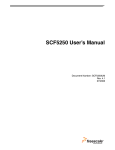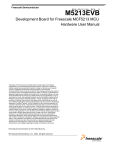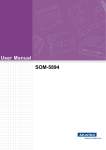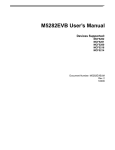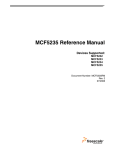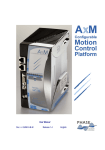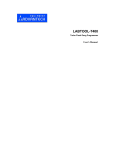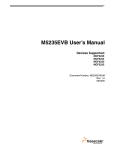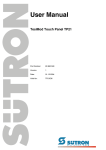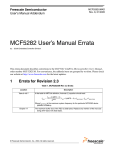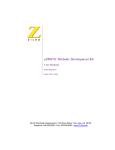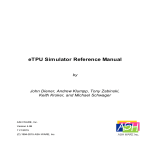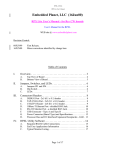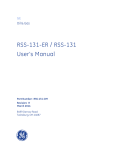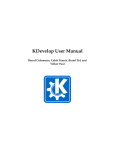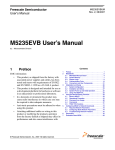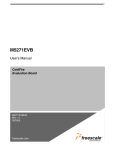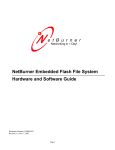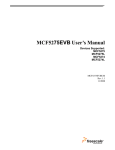Download M5235BCC EVB
Transcript
CMM-5235 Evaluation Module for Freescale MCF5235 MCU Hardware User Manual M5235BCC EVB M5235 Business Card Controller ! Axiom Manufacturing • 2813 Industrial Lane • Garland, TX 75041 Email: [email protected] Web: http://www.axman.com ! C M M - 5 2 3 5 U S E R M A N U A L V 1 . 0 0 9 / 1 4 / 0 4 CONTENTS CAUTIONARY NOTES ...........................................................................................................................................................3 TERMINOLOGY ......................................................................................................................................................................3 FEATURES................................................................................................................................................................................4 GETTING STARTED...............................................................................................................................................................5 SOFTWARE DEVELOPMENT .......................................................................................................................................................5 REFERENCE DOCUMENTATION .................................................................................................................................................5 CMM-5235 STARTUP...............................................................................................................................................................6 CMM-5235 HARDWARE CONFIGURATION AND OPTIONS ........................................................................................6 POWER SUPPLY ...................................................................................................................................................................7 RESET .....................................................................................................................................................................................7 INDICATORS .........................................................................................................................................................................7 ABORT SWITCH ......................................................................................................................................................................7 SYSTEM CLOCK ...................................................................................................................................................................8 MEMORY ...............................................................................................................................................................................8 COMMUNICATION PERIPHERALS ...................................................................................................................................8 OPTION JUMPERS ................................................................................................................................................................8 CMM-5235 PORTS AND CONNECTORS ..........................................................................................................................10 PWR - POWER JACK...............................................................................................................................................................10 COM PORT.............................................................................................................................................................................10 CAN PORT .............................................................................................................................................................................10 J1 ETHERNET PORT ............................................................................................................................................................11 BDM_PORT..........................................................................................................................................................................11 MCU_PORT..........................................................................................................................................................................12 BUS_PORT ...........................................................................................................................................................................13 ETPU_PORT .........................................................................................................................................................................13 TROUBLESHOOTING ............................................................................................................................................................14 DBUG MONITOR OPERATION..........................................................................................................................................15 DBUG DBUG COMMUNICATION: ......................................................................................................................................................15 SYSTEM INITIALIZATION .............................................................................................................................................15 Interrupt Service Support ..................................................................................................................................................15 DBUG MEMORY MAP ............................................................................................................................................................16 DBUG COMMANDS ................................................................................................................................................................17 dBUG Command Table .....................................................................................................................................................17 DBUG ETHERNET SUPPORT ...................................................................................................................................................18 Configuring dBUG Network Parameters ..........................................................................................................................19 APPENDIX 1: DBUG COMMAND SET ..............................................................................................................................20 ASM - ASSEMBLER ...............................................................................................................................................................20 BC - BLOCK COMPARE...........................................................................................................................................................21 BF - BLOCK FILL ....................................................................................................................................................................21 BM - BLOCK MOVE................................................................................................................................................................22 BR - BREAKPOINTS ................................................................................................................................................................22 BS - BLOCK SEARCH ..............................................................................................................................................................23 DC - DATA CONVERSION .......................................................................................................................................................24 DI - DISASSEMBLE .................................................................................................................................................................24 DL - DOWNLOAD CONSOLE ...................................................................................................................................................25 DLDBUG – DOWNLOAD DBUG (UPDATE)............................................................................................................................26 DN - DOWNLOAD NETWORK..................................................................................................................................................26 FL – FLASH LOAD OR ERASE .................................................................................................................................................27 GO – EXECUTE USER CODE ....................................................................................................................................................28 GT - EXECUTE TO ADDRESS ..................................................................................................................................................28 1 C M M - 5 2 3 5 U S E R M A N U A L V 1 . 0 0 9 / 1 4 / 0 4 IRD - INTERNAL REGISTER DISPLAY ......................................................................................................................................29 IRM - INTERNAL REGISTER MODIFY ......................................................................................................................................29 HELP - HELP .........................................................................................................................................................................30 LR - LOOP READ ....................................................................................................................................................................30 LW - LOOP WRITE .................................................................................................................................................................30 MD - MEMORY DISPLAY ........................................................................................................................................................31 MM - MEMORY MODIFY ........................................................................................................................................................31 MMAP - MEMORY MAP DISPLAY..........................................................................................................................................32 RD - REGISTER DISPLAY ........................................................................................................................................................33 RM - REGISTER MODIFY ........................................................................................................................................................33 RESET - RESET THE BOARD AND DBUG ...............................................................................................................................34 SET - SET CONFIGURATIONS..................................................................................................................................................34 SHOW - SHOW CONFIGURATIONS .........................................................................................................................................35 STEP - STEP OVER .................................................................................................................................................................35 SYMBOL - SYMBOL NAME MANAGEMENT...........................................................................................................................36 TRACE - TRACE INTO ...........................................................................................................................................................37 UP – UPLOAD NETWORK ........................................................................................................................................................37 VERSION - DISPLAY DBUG VERSION ..................................................................................................................................37 TRAP #15 FUNCTIONS ...........................................................................................................................................................38 OUT_CHAR.......................................................................................................................................................................38 IN_CHAR...........................................................................................................................................................................39 CHAR_PRESENT ..............................................................................................................................................................39 EXIT_TO_dBUG ...............................................................................................................................................................40 2 C M M - 5 2 3 5 U S E R M A N U A L V 1 . 0 0 9 / 1 4 / 0 4 Cautionary Notes 1) Electrostatic Discharge (ESD) prevention measures should be applied whenever handling this product. ESD damage is not a warranty repair item. 2) Axiom Manufacturing reserves the right to make changes without further notice to any products to improve reliability, function or design. Axiom Manufacturing does not assume any liability arising out of the application or use of any product or circuit described herein; neither does it convey any license under patent rights or the rights of others. 3) EMC Information on the CMM-5235 board: a) This product has been tested and meets with requirements of CE and the FCC as a CLASS A product when applied with appropriate power supply and cables. b) This product is designed and intended for use as a development platform for hardware or software in an educational / professional laboratory or as a component in a larger system. c) In a domestic environment this product may cause radio interference in which case the user may be required to take adequate prevention measures. d) Attaching additional wiring to this product or modifying the products operation from the factory default as shipped may effect its performance and also cause interference with other apparatus in the immediate vicinity. If such interference is detected, suitable mitigating measures should be taken. Terminology This development board applies option selection jumpers. Terminology for application of the option jumpers is as follows: Jumper on, in, or installed = jumper is a plastic shunt that fits across 2 pins and the shunt is installed so that the 2 pins are connected with the shunt. Jumper off, out, or idle = jumper or shunt is installed so that only 1 pin holds the shunt, no 2 pins are connected, or jumper is removed. It is recommended that the jumpers be placed idle by installing on 1 pin so they will not be lost. This development board applies CT (cut trace) or option selections that require a soldering tool to install or remove. This type connection places an equivalent Jumper Installed type option. Applying the connection can be performed by installing a 0 ohm resistor component or small wire between the option pads. See the Options section for more details. 3 C M M - 5 2 3 5 U S E R M A N U A L V 1 . 0 0 9 / 1 4 / 0 4 FEATURES The M5235BCC / CMM-5235 is a low cost evaluation module in Business Card Controller (BCC) format for the Freescale MCF5235 Coldfire microcontroller. Application development is quick and easy with the included Axiom CMM-5235 module / application board, DB9 serial cable, Ethernet cable, 3rd party Demo Software, Freescale dBUG monitor, and GNU Software Tool Package that includes C compiler and source level debug utilities. The BDM port is compatible with standard Coldfire® BDM / JTAG Low voltage development cables. The installed monitor software allows easy application debugging and development. Features: ♦ MCF5235 CPU * 64K Byte Ram (on chip) * 8K Byte Cache Ram (on chip) * 16 Channel ETPU module * DMA Controller w/ Timers * Interrupt Controller * QSPI, IIC, and 2x CAN Serial Ports * 3 x SCI UART Ports with DMA capability * Edge / Interrupt Port * BDM / JTAG Port * 3.3V / 1.5V operation * Up to 150Mhz operation ♦ 2M Byte Flash (16 bit, external) ♦ 16M Bytes SDRAM (32 bit, external) ♦ 25Mhz reference crystal, up to 100Mhz operation ♦ MCU Port, 50 pin GPIO port w/ 1 x 1Mb CAN I/O ♦ ETPU Port, 20 pins, 16 channels w/ +V supply ♦ BUS Port, 34 pins, 64K Address, 8 bit Data Bus, 3 selects ♦ BDM / JTAG Port, 26 Pins, development port. ♦ COM Port (UART0) w/ RS232 DB9-S Ribbon Connector ♦ 10/100TX Ethernet Port w/ RJ45 Connector, 4 status Indicators, Auto MDI-X crossover. ♦ CAN port w/ 1Mbaud transceiver, on MCU Port ♦ RESET switch and indicator M5235BCC / CMM-5235 ♦ ABORT (IRQ7) switch ♦ Regulated +3.3V and +1.5V power supply w/ indicator ♦ BCC kit supplied with DB9 Serial Cable, Cat 5E Ethernet cable, BDM Development Cable, Utility / Support CD, Manuals, and Universal Wall Adapter power supply. Specifications: Board Size 3.5” x 2.2 inches w/ 4 x #2 mounting holes Power Input: +5 - +30VDC, 12VDC typical Current Consumption: 120ma @ 12VDC input typical (100Mhz clock) The CMM-5235 is provided, operating the Freescale dBUG monitor firmware. The monitor allows serial interface to a PC host for file loading and terminal command line operations. Ethernet operation supports TFTP file downloads into the development board. The support CD contains GNU Tool package, device data sheets, PC Terminal software, and user manuals. The kit is plug in and play out of the box with a wall adapter power supply. No additional hardware or software is required. 4 C M M - 5 2 3 5 U S E R M A N U A L V 1 . 0 0 9 / 1 4 / 0 4 GETTING STARTED The CMM-5235 single board computer is a fully assembled, fully functional development board for the Freescale MCF5235 microcontroller. Provided with wall plug power supply, Ethernet cable, and serial cable. Provided support software for this development board is for Windows 95/98/NT/2000/XP operating systems. Development board users should also be familiar with the hardware and software operation of the target MCF5235 device, refer to the provided Freescale User Guide for the device and the Coldfire Reference Manual for details. The development board purpose is to assist the user in quickly developing an application with a known working environment, to provide an evaluation platform, or as a control module for an applied system. Users should be familiar with memory mapping, memory types, and embedded software design for the quickest successful application development. Software Development Application development maybe performed by applying the dBUG firmware monitor, or by applying a compatible Coldfire BDM / JTAG cable with supporting host software. The monitor provides an effective and low cost command line debug method. Software development is best performed with a development tool connected to the BDM port. This provides real-time access to all hardware, peripherals and memory on the board. Development tool software also provides high-level (C/C++) source code debug environment. The target development environment and procedure for best success is to place software to be tested into RAM memory. Execute software to be tested under dBUG monitor or development tool control, after software is tested and operational, port and program application into FLASH memory to execute new application when power is applied. Reference Documentation Reference documents are provided on the support CD in Acrobat Reader® format. CMM-5235_man.pdf – This user manual. MCF5235UM.pdf – MCF5235 Device User Manual CFPRM.pdf – Coldfire Programmers Reference Manual with instruction set CMM-5235_SCH_C.pdf – CMM5235 board schematics 5 C M M - 5 2 3 5 U S E R M A N U A L V 1 . 0 0 9 / 1 4 / 0 4 CMM-5235 Startup Follow these steps to connect and power on the board for the default dBUG monitor operation. 1) Carefully unpack the CMM-5235 and observe ESD preventive measures while handling the CMM-5235 development board. 2) Load the ColdFire support CD into the PC and install the AxIDE terminal software from the utilities directory, OR configure HyperTerminal for a direct connection to the PC COM port to be applied for serial communication with the CMM-5235 board. Set the baud rate to 19.2K baud, 8 data bits, 1 stop bit, and no parity. Software XON / XOFF flow control should be enabled for flash memory support operations. Use the AxIDE ‘√’ tool bar button to configure the COM port on the PC. 3) Connect the CMM-5235 board COM1 serial port connector to the host PC COM port with the provided 9 pin serial cable. 4) Apply power to the development board by installing the wall plug power supply between a wall outlet and the PWR Jack on the board. The board voltage indicators should turn on at this time. 5) Observe the AxIDE or HyperTerminal window display for the dBUG monitor prompt. prompt should be similar to the following: Hard Reset DRAM Size: 16M Copyright 1995-2003 Freescale, Inc. All Rights Reserved. ColdFire MCF5235 BCC Firmware v2e.1a.xx (Build XXX on XXX XX 20XXxx:xx:xx) Enter 'help' for help. dBUG> 6) The board is ready to use now. See the dBUG monitor manual for additional monitor information. If BDM / JTAG development port interfaced tools are to be applied, see the BDM PORT section of this manual for more details on installation. CMM-5235 Hardware Configuration and Options The CMM-5235 board provides a basic development or evaluation platform for the MCF5235 microcontroller. Operating mode of the MCF5235 is set at RESET for Master Mode, 32 bit bus, 16 bit boot device (flash), crystal oscillator. Following are descriptions of the main components and options provided on the board. 6 C M M - 5 2 3 5 U S E R M A N U A L V 1 . 0 0 9 / 1 4 / 0 4 POWER SUPPLY Input power is applied by external connection to the PWR power jack. The input supply is provided to the main 3.3V regulator VR1. VR2 provides 1.5V from the 3.3V supply for the MCF5235 core voltage. Ethernet PHY device U7 generates its own +2.5V operating voltage from the 3.3V supply. With +5 to +30VDC applied at the PWR jack, the +3.3V indicator should be ON. RESET External reset is provided by the RESET switch, LV1 low voltage detector, or user applied connection to the RESET* signal on the MCU PORT. If the main 3.3V supply is below operating level, the LV1 voltage detector will cause the MCF5235 to stay in the RESET condition. RESET switch provides for manual application of the MCF5235 RESET* signal. Both the RESET switch and LV1 provide a 150ms delay after release for the system to stabilize. Application of RESET will cause the dBUG monitor or user application to initialize the MCF5235. Previous SDRAM memory content and operating state of the MCF5235 will be lost. INDICATORS Indication is provided for power supply status, CPU Reset status, and Ethernet status. The indications may be applied to determine proper operation of the development board. Indicator Summary INDICATOR +3.3V RESET LNK 100 COLOR Green RED Green Green OPERATION +3.3V power present CPU is in RESET state Ethernet has Link Ethernet is operating 100 base DUP COL Green RED Ethernet is operating full duplex Ethernet is experiencing packet collisions DEFAULT CONDITION ON OFF ON with Network connected ON if 100 base network, OFF if 10 base network ON if full duplex network OFF unless network has a problem ABORT Switch The ABORT switch provides for manual application of the IRQ7 interrupt signal. This operation will allow the dBUG monitor to stop execution of a user program and maintain the CPU operating state for user examination. After application of the ABORT switch, dBUG will prompt the current program instruction pending. Display is similar to a breakpoint operation. 7 C M M - 5 2 3 5 U S E R M A N U A L V 1 . 0 0 9 / 1 4 / 0 4 SYSTEM CLOCK The reference oscillator is an 25MHz crystal. MCF5235 clock is generated by the internal PLL from the reference frequency for operation up to 150Mhz. CMM-5235 / BCC operation is rated at 100Mhz but higher speed operation is possible. User applications can change the clock setting under software control. Caution should be applied so that communication with the dBUG monitor is not lost due to clock frequency and serial baud rate change. MEMORY Memory is provided in the MCF5235 device and externally on the development board. The MCF5235 provides 64K bytes of SRAM memory internally. Board memory consists of 16M Bytes of SDRAM and 2M bytes of Flash memory standard. The debug monitor occupies the first or lower 256K bytes of the board Flash memory. User should refer to the dBUG memory map for default memory allocation and physical locations. Memory Devices: SDRAM = 2 x Micron MT48LC4M16A2 or same for 32 bit wide SDRAM bank of 16M bytes. SDRAM controller is dedicated to this interface. Optional upgrade to 32M byte bank is possible with 2 x MT48LC8M16 devices installed, contact factory for special configurations. FLASH = 1 x AMD AM29LV160B or same for 16 bit wide flash bank of 2M bytes. CS0* chip select is dedicated to this memory bank. Optional flash bank sizes from 256K to 8M bytes is possible. Contact factory for special configurations. Note: The MCF5235 SDRAM controller must be configured prior to application of the memory space when BDM or JTAG tools are applied. COMMUNICATION PERIPHERALS The CMM-5235 provides 3 conditioned communication ports, 10/100T Ethernet, RS232 Serial COM, and CAN. User should refer to the respective manual chapter for details of operation and connection of each port. OPTION JUMPERS Option jumpers are provided for the most common user required selections. Option summary OPTION DB_EN BDM_EN JP2 OPERATION Enable the dBUG monitor in flash memory. Enable BDM mode on the development port. Enable Ethernet PHY interrupt on IRQ6 8 DEFAULT Position Installed Idle (must be installed to apply BDM cable) Idle / Open C M M - 5 2 3 5 U S E R M A N U A L V 1 . 0 0 9 / 1 4 / 0 4 BDM_EN The BDM_EN option must be installed to operate the PE Coldfire cable or similar BDM type development cable. Option = open will place the development port in JTAG mode for JTAG compatible cables. INSTALLED = BDM_PORT is in BDM Mode (Development mode = BDM). OPEN = BDM_PORT is in JTAG Mode (Development mode = JTAG). DB_EN Option allows dBUG firmware to remain resident in the external flash while a dedicated user application operates from RESET. Jumper operation will enable or disable the dBUG monitor portion of the flash memory. Opening this option jumper removes the dBUG firmware and lower half of the flash memory device from the MCF5235 memory map. This allows a user application to be started at RESET instead of the monitor for dedicated application operation. To recover the dBUG monitor the DB_EN option is installed and BCC board RESET. Applications developed with BDM or JTAG tool support do not need the dBUG monitor to be resident. In this case the DB_EN option should remain installed so the user has access to all of the flash memory space. Procedure to load user application for dedicated operation from RESET: 1) Compile and link application code to be located at the flash base address: 0xFFE00000. 2) With DB_EN option installed, apply the dBUG monitor command: “FL erase FFF00000 100000” This will erase the top half of the flash memory. 3) Load the application program with the dBUG monitor command: “DL 100000” Then send the application program S record to the board with the terminal software upload operation. Make sure the XON / XOFF flow controls are enabled or errors may occur. 4) Remove or idle the DB_EN option jumper and apply RESET to launch the application. If the application program is functional, it will operate at this time. 5) to recover the dBUG monitor, install the DB_EN option on both pins and apply RESET. dBUG should prompt on the serial port. JP2 This option enables the U7 Ethernet PHY device interrupt on the MCF5235 IRQ6 interrupt. Note that software support is also required for this option. 9 C M M - 5 2 3 5 U S E R M A N U A L V 1 . 0 0 9 / 1 4 / 0 4 CMM-5235 PORTS AND CONNECTORS PWR - Power Jack PWR provides the default power input to the board. The power jack accepts a standard 2.0 ~ 2.1mm center barrel plug connector (positive voltage center) to provide the +VIN supply of +5 to +30 VDC (+9VDC typical). +Volts, 2mm center COM Port The COM port provides a 10 pin ribbon connection for a standard socket type 9 pin serial connector. The port provides RS232 type interface to the MCF5235 UART0 peripheral. The COM1 port is applied by the dBUG monitor at 19.2K baud default. Following is the connection reference. COM1 DB9-1 DB9-2 TXD DB9-3 RXD DB9-4 DB9-5 GND 1 2 3 4 5 6 7 8 9 10 DB9-6 CTS DB9-7 RTS DB9-8 DB9-9 N/C The COM port is a DB9 socket connector with RS232 signal levels. CTS / RTS are enabled by options RTS and CTS to MCF5235 signals RTS0 and CTS0 respectfully for UART0 hardware flow control. 1,4,6 connected for status null to host The 1, 4, 6 and 9 pins provide RS232 status signals RTS and CTS OPTION PADS – Apply 0805 SMT size 0 ohm resistors or wire ties across the option pads to enable MCF5235 RTS0* output and CTS0* input signals for hardware flow control operation on the COM1 port. These signals should also be enabled in UART0 by the user application. CAN Port The CAN port provides the physical interface layer for the MCF5235 FlexCAN Controller Area Network version 2.0B peripheral. The FlexCAN channel 0 transmit and receive signals provided on the UART1 RXD1 and TXD1 signal pins from the MCF5235 are connected to a 3.3V CAN transceiver capable of 1M baud communication (SN65HVD230). Transceiver differential CAN network signals CAN_HI and CAN_LO are provided a 62 ohm termination and applied to the MCU PORT connector pins 49 and 50 respectfully. 10 C M M - 5 2 3 5 U S E R M A N U A L V 1 . 0 0 9 / 1 4 / 0 4 The CAN transceiver has CAN signal drive control via the RS test pad on the development board. The RS signal is provided a 1K Ohm pull-down resistor for the maximum signal rate setting. User may refer to the SN65HVD230 data sheet and apply additional signal control at the RS test pad. The port connector accepts standard .1 inch space .025 square pin socket connectors. CANTX0 (UTXD1) and CANRX0 (URXD1) signals can be isolated by CT1 and CT2 cut-away options for user application applied via the MCU Port. J1 ETHERNET Port J1 provides the Ethernet physical interface connection. Port configuration applies a Micrel KS8721BL 10/100T physical layer transceiver (PHY) to the MCF5235 Fast Ethernet Controller (FEC/MAC) for a complete IEEE802.3 interface. Features of the port include Auto MDX cable or connection configuration type detection, 4 status indicators, and an integrated transformer RJ45 connector. The JP2 interrupt option can be applied by the user for PHY status interrupt services via IRQ6 in the MCF5235. Refer to the KS8121 data sheet for register and operation details. Ethernet Status Indicators LNK 100 Green Green Ethernet has Link Ethernet is operating 100 base DUP COL Green RED Ethernet is operating full duplex Ethernet is experiencing packet collisions ON with Network connected ON if 100 base network, OFF if 10 base network ON if full duplex network OFF unless network has a problem Note: Ethernet port must be initialized and operating for status indications. Refer to the CMM5235_SCH_C.pdf drawing for details on hardware connections to this port. BDM_PORT The BDM PORT provides a standard Coldfire BDM / JTAG development port. The BDM_EN option provides for the development port mode selection between BDM or JTAG. To Host PC Development Cable Installation Pin 1 CMM-5235 board BDM Port 11 C M M - 5 2 3 5 U S E R M A N U A L V 1 . 0 0 9 / 1 4 / 0 4 BDM /JTAG Port Connection 1 3 5 7 9 11 13 15 17 19 21 GND 23 +1.5V 25 GND GND RESET* +3.3V GND PST2 PST0 DDATA2 DDATA0 2 4 6 8 10 12 14 16 18 20 22 24 26 BKPT* DSCLK TCLK DSI DSO PST3 PST1 DDATA3 DDATA1 GND TCLK TA* MCU_PORT The MCU PORT provides access to the MCF5235 I/O ports. (Note 1) SCL LTPU RESET* TEA* TSIZ0 TSIZ1 CS6* CS4* CS2* DTIN3 DTIN2 DTIN1 DTIN0 UTXD2/CANTX1 UCTS1 (Note 1) UTXD0 CANRX0 / URXD1 QSPICS1 QSPICLK QSPIDOUT IRQ6* IRQ4* IRQ2* GND CAN_HI 1 3 5 7 9 11 13 15 17 19 21 23 25 27 29 31 33 35 37 39 41 43 45 47 49 2 4 6 8 10 12 14 16 18 20 22 24 26 28 30 32 34 36 38 40 42 44 46 48 50 SDA CLKOUT RSTO* TIP* TS* CS7* CS5* CS3* CS1* DTOUT3 DTOUT2 DTOUT1 DTOUT0 URXD2/CANRX1 URTS1 URXD0 (Note 1) CANTX0 / UTXD1 QSPICS0 QSPIDIN (Note 1) IRQ7* IRQ5* IRQ3* IRQ1* +3.3V CAN_LO Note 1: These signals have peripheral connection on the CMM-5235 board. 12 C M M - 5 2 3 5 U S E R M A N U A L V 1 . 0 0 9 / 1 4 / 0 4 BUS_PORT The BUS PORT provides 64K Byte access space with 3 selects to peripherals. All signals on the BUS PORT have a peripheral connection on the CMM-5235 board. Application of the BUS signals will require the addition of buffers on the external connections. D24 D26 D28 D30 A0 A2 A4 A6 A8 A10 A12 A14 CS1* CS3* BS3* TS* +3.3V 1 3 5 7 9 11 13 15 17 19 21 23 25 27 29 31 33 2 4 6 8 10 12 14 16 18 20 22 24 26 28 30 32 34 D25 D27 D29 D31 A1 A3 A5 A7 A9 A11 A13 A15 CS2* OE* R/W* TA* GND ETPU_PORT The ETPU PORT provides access to the MCF5235 ETPU signals. TPU channels 0 – 15 are provided I/O access on the port. TPUCH0 TPUCH2 TPUCH4 TPUCH6 TPUCH8 TPUCH10 TPUCH12 TPUCH14 TCRCLK +3.3V 1 3 5 7 9 11 13 15 17 19 2 4 6 8 10 12 14 16 18 20 TPUCH1 TPUCH3 TPUCH5 TPUCH7 TPUCH9 TPUCH11 TPUCH13 TPUCH15 GND +VIN 13 C M M - 5 2 3 5 U S E R M A N U A L V 1 . 0 0 9 / 1 4 / 0 4 TROUBLESHOOTING The CMM-5235 is fully tested and operational before shipping. If it fails to function properly, inspect the board for obvious physical damage first. Verify the communications setup as described under GETTING STARTED. The most common problems are improperly configured options or communications parameters. 1. Verify default option settings and RESET the board. 2. Make sure that the RESET* line is not being held low or the RESET indicator is not on constantly. 3. Verify that your COM communications port is working by substituting a known good serial device or by doing a loop back diagnostic. if you applied a different baud rate with the dBUG SET command, make sure the terminal software is set correctly. 4. Verify the power source, +3.3V Indicator is ON? You should measure a minimum of 9 volts between the GND and +VIN (GND Test Point and ETPU Port pin 20) with the standard power supply provided. 5. If no power indications or voltage is found, verify the wall plug connections to AC outlet and the PWR jack power connector. 6. Disconnect all external connections to the board except for COM to the PC and the wall plug and check operation again. 7. Contact [email protected] by email for further assistance. Provide board name and describe problem. 14 C M M - 5 2 3 5 U S E R M A N U A L V 1 . 0 0 9 / 1 4 / 0 4 dBUG MONITOR OPERATION dBUG is a firmware resident development environment operated by the MCF5235 as a primary control program. The monitor provides serial and Ethernet communication for loading and controlling the execution of software under test. User should note that the monitor occupies the first or lower address ~256K bytes of the external flash memory. Caution should be applied in the user application not to corrupt the monitor flash memory space. If the monitor is corrupted, a development port tool will be required to restore operation. dBUG Communication: Primary user interface to the dBUG monitor is by command lines that are entered into the serial port. These commands are defined in the following table “dBUG Commands”. For serial communications, dBUG requires eight data bits, no parity, and one stop bit, 8N1 with XON/XOFF soft flow control. The default baud rate is 19200 however, this rate can be changed by the user with a “set” command. The command line prompt is “dBUG> “. Any dBUG command may be entered from this prompt. dBUG does not allow command lines to exceed 80 characters. Wherever possible, dBUG displays data in 80 columns or less. dBUG echoes each character as it is typed, eliminating the need for any “local echo” on the terminal side. In general, dBUG is not case sensitive. Commands may be entered either in upper or lower case, depending upon the user’s equipment and preference. Only symbol names require that the exact case be used. See the dBUG Ethernet Support section in this manual for details on operating this port. dBUG System Initialization The act of powering up the board will initialize the system. The processor is reset and dBUG is invoked. dBUG performs the following configurations of internal resources during the initialization: MCF5235 clock is initialized to 100 MHz. The instruction cache is invalidated and disabled. The Software Watchdog Timer is disabled and internal timers are placed in a stop condition. dBUG memory map is configured. Interrupt Service Support Interrupt controller register is initialized with unique interrupt level/priority pairs. Please refer to the dBUG source files on the ColdFire support CD for the complete initialization code sequence. 15 C M M - 5 2 3 5 U S E R M A N U A L V 1 . 0 0 9 / 1 4 / 0 4 The Vector Base Register, VBR, points to the dBUG Flash memory space. However, a copy of the exception table is made at address $00000000 in SDRAM memory space. To take over an exception vector, the user places the address of the exception handler in the appropriate vector in the vector table located at 0x00000000, and then points the VBR register to 0x00000000. See the MCF5235 User Guide and ColdFire Programmers Reference Manual for more details on applying interrupts. dBUG Memory Map 0x00000000 External SDRAM Memory: User Vector table if applied. See Interrupt Support for more information. 0x000003FF 1K bytes 0x00000400 External SDRAM Memory: dBUG reserved ram space. 0x0001FFFF 128K bytes 0x00010000 External SDRAM Memory: User ram or development memory space 0x00FFFFFF 16M bytes, 32 bits wide 0x01000000 - 0x1FFFFFFF Not applied memory space. reserved 0x20000000 MCF5235 Internal SRAM memory space, user space. 0x2000FFFF 64K bytes, 32 bits wide 0x20010000 - 0x3FFFFFFF Not applied memory space. reserved 0x40000000 ISBAR: MCF5235 Internal register and peripheral space. 0x7FFFFFFF Refer to MCF5235 User Manual for details. 0x80000000 - 0xFFDFFFFF Not applied memory space. reserved 0xFFE00000 dBUG Monitor Flash Memory Space. reserved 0xFFE3FFFF 256K bytes 0xFFE40000 User External Flash Memory Space 0xFFFFFFFF 1.8M bytes, 16 bits wide Note: Applying BDM / JTAG development port tools does not require following the dBUG memory map. 16 C M M - 5 2 3 5 U S E R M A N U A L V 1 . 0 0 9 / 1 4 / 0 4 dBUG Commands After the system initialization, the dBUG waits for a command-line input from the user terminal. When a proper command is entered, the operation continues in one of the two basic modes. If the command causes execution of the user program, the dBUG firmware may or may not be re-entered, at the discretion of the user’s program. For the alternate case, the command will be executed under control of the dBUG firmware, and after command completion, the system returns to command entry mode. dBUG Command Table MNEMONIC ASM BC BF BM BR BS DC DI DL DLDBUG DN FL GO GT HELP IRD IRM LR LW MD MM MMAP RD RM RESET SD SET SHOW STEP SYM TRACE UP VER SYNTAX DESCRIPTION asm <<addr> stmt bc addr1 addr2 length bf <width> begin end data <inc> bm begin end dest br addr <-r> <-c count> <-t trigger> bs <width> begin end data dc value di <addr> dl <offset> dldbug dn <-c> <-e> <-i> <-s> <-o offset> <filename> fl <command> dest <src> size go <addr> gt addr help <command> ird <module.register> Internal irm module.register data lr <width> addr lw <width> addr data md <width> <begin> <end> mm <width> addr <data> mmap rd <reg> rm reg data reset sd set <option value> show <option> step symbol <symb> <-a symb value> <-r symb> <-C| l |s> trace <num> up begin end filename version Assemble Block Compare Block Fill Block Move Breakpoint Block Search Data Convert Disassemble Download Serial Download dBUG Update Download Network Flash write or erase Execute Execute To Help Internal Register Display Internal Register Modify Loop Read Loop Write Memory Display Memory Modify Memory Map Display Register Display (core) Register Modify (core) Reset Stack Display (contents) Set Configurations Show Configurations Step (Over) Symbol Management Trace (Into) Upload binary data Show dBUG Version During command execution, additional user input may be required depending on the command function. For commands that accept an optional <width> to modify the memory access size, the valid values are: • B = 8-bit (byte) access • W = 16-bit (word) access 17 • L = 32-bit (long) access C M M - 5 2 3 5 U S E R M A N U A L V 1 . 0 0 9 / 1 4 / 0 4 When no <width> option is provided, the default width is “W”, 16-bit. The core ColdFire register set is maintained by dBUG. These are listed below: • A0 - A7 • D0 - D7 • PC • SR All control registers on ColdFire are not readable by the supervisor-programming model, and thus not accessible via dBUG. User code may change these registers, but caution must be exercised as changes may render dBUG inoperable. A reference to “SP” (stack pointer) actually refers to general purpose address register seven, “A7.” The commands DI, GO, MD, STEP and TRACE are used repeatedly when debugging. dBUG recognizes this and allows for repeated execution of these commands with minimal typing. After a command is entered, simply press <RETURN> or <ENTER> to invoke the command again. The command is executed as if no command line parameters were provided. User programs are provided access to various dBUG routines by the “Trap 15 Functions". These functions are discussed at the end of this chapter. dBUG Ethernet Support Ethernet support by the dBUG monitor is limited to TFTP (Trivial File Transfer Protocol) downloads of object code files. Note that this operation requires an Ethernet TFTP server to be running on the host (usually a PC) attached to the development board. The support CD provides simple TFTP host software (TFTPD32) for a Windows based PC if needed. Prior to using this feature, several parameters must be configured for network downloads to occur. The information that is required and the steps for configuring dBUG are described below. Required Network Parameters: To perform network downloads, dBUG needs 7 parameters of which 5 are network-related and 2 are download-related. The parameters are listed below, with the dBUG designation following in parenthesis. All computers connected to an Ethernet network running the IP protocol need 4 network-specific parameters. These parameters are: • Internet Protocol • IP address for the computer (client IP) • IP address of the Gateway for non-local traffic (gateway IP) • Network netmask for flagging traffic as local or non-local (netmask) In addition, the dBUG network download command requires the following three parameters: • • • IP address of the TFTP server (server IP) Name of the file to download (filename) Type of the file to download (file type of S-record, COFF, ELF, or Image) Your local system administrator can assign a unique IP address for the board, and also provide you the IP addresses of the gateway, netmask, and TFTP server. Fill out the lines below with this information: 18 C M M - 5 2 3 5 U S E R M A N U A L V 1 . 0 0 9 / 1 4 / 0 4 Client IP: ___.___.___.___ (IP address of the board) Server IP: ___.___.___.___ (IP address of the TFTP server) Gateway: ___.___.___.___ (IP address of the gateway) Netmask: ___.___.___.___ (Network netmask) Configuring dBUG Network Parameters Once the network parameters are known, the dBUG Monitor must be configured. The following commands are used to configure the network parameters: set set set set set client <client IP> server <server IP> gateway <gateway IP> netmask <netmask> mac <addr> For an example, the TFTP server has IP address of 123.45.67.1. The board is assigned the IP address of 123.45.68.15. The gateway IP address is 123.45.68.250, and the netmask is 255.255.255.0. The MAC address is chosen arbitrarily and is unique. The commands to dBUG are: set client 123.45.68.15 set server 123.45.67.1 set gateway 123.45.68.250 set netmask 255.255.255.0 set mac 00:CF:52:82:EB:01 The last step is to inform dBUG of the name and type of the file to download. Prior to giving the name of the file, keep in mind that the host TFTP server will require the file to be transferred be in the TFTP server’s assigned base directory or a subdirectory from the base directory (depends on security settings). See the TFTP server software setup configuration and help file to locate or change this directory. A default file name for network downloads is maintained by dBUG. To change the default file name, use the command: set filename <filename> When using the Ethernet network for download, either S-record, COFF, ELF, or Image files may be downloaded. A default file type for network downloads is maintained by dBUG as well. To change the default file type, use the command: set filetype <S record | coff | elf | image> 19 C M M - 5 2 3 5 U S E R M A N U A L V 1 . 0 0 9 / 1 4 / 0 4 Continuing with the above example, the Coldfire C compiler produces an executable COFF file, ‘example.out’. This file is copied to the TFTP server base directory for download to dBUG. Note: If the TFTP server base directory is assigned to the compiler output files directory on the host PC, no file copy to another directory is required. Change the dBUG default filename and file type with the commands: set filename example.out set filetype coff Finally, perform the network download with the ‘dn’ command. The network download process uses the configured IP addresses and the default filename and file type for initiating a TFTP download from the TFTP server. Appendix 1: dBUG Command Set ASM - Assembler Usage: ASM <<addr> stmt> The ASM command is a primitive assembler. The <stmt> is assembled and the resulting code placed at <addr>. This command has an interactive and non-interactive mode of operation. The value for address <addr> may be an absolute address specified as a hexadecimal value, or a symbol name. The value for stmt must be valid assembler mnemonics for the CPU. For the interactive mode, the user enters the command and the optional <addr>. If the address is not specified, then the last address is used. The memory contents at the address are disassembled, and the user prompted for the new assembly. If valid, the new assembly is placed into memory, and the address incremented accordingly. If the assembly is not valid, then memory is not modified, and an error message produced. In either case, memory is disassembled and the process repeats. The user may press the <Enter> or <Return> key to accept the current memory contents and skip to the next instruction, or a enter period to quit the interactive mode. In the non-interactive mode, the user specifies the address and the assembly statement on the command line. The statement is the assembled, and if valid, placed into memory, otherwise an error message is produced. Examples: To place a NOP instruction at address 0x0001_0000, the command is: asm 10000 nop To interactively assembly memory at address 0x0040_0000, the command is: asm 400000 20 C M M - 5 2 3 5 U S E R M A N U A L V 1 . 0 0 9 / 1 4 / 0 4 BC - Block Compare Usage: BC addr1 addr2 length The BC command compares two contiguous blocks of memory on a byte by byte basis. The first block starts at address addr1 and the second starts at address addr2, both of length bytes. If the blocks are not identical, the address of the first mismatch is displayed. The value for addresses addr1 and addr2 may be an absolute address specified as a hexadecimal value or a symbol name. The value for length may be a symbol name or a number converted according to the user defined radix (hexadecimal by default). Example: To verify that the data starting at 0x20000 and ending at 0x3_0000 is identical to the data starting at 0x8_0000, the command is: bc 20000 80000 10000 BF - Block Fill Usage: BF<width> begin end data <inc> The BF command fills a contiguous block of memory starting at address begin, stopping at address end, with the value data. <Width> modifies the size of the data that is written. If no <width> is specified, the default of word sized data is used. The value for addresses begin and end may be an absolute address specified as a hexadecimal value, or a symbol name. The value for data may be a symbol name, or a number converted according to the user-defined radix, normally hexadecimal. The optional value <inc> can be used to increment (or decrement) the data value during the fill. This command first aligns the starting address for the data access size, and then increments the address accordingly during the operation. Thus, for the duration of the operation, this command performs properly-aligned memory accesses. Examples: To fill a memory block starting at 0x2_0000 and ending at 0x4_0000 with the value 0x1234, the command is: bf 20000 40000 1234 To fill a block of memory starting at 0x20000 and ending at 0x4_0000 with a byte value of 0xAB, the command is: bf.b 20000 40000 AB 21 C M M - 5 2 3 5 U S E R M A N U A L V 1 . 0 0 9 / 1 4 / 0 4 To zero out the BSS section of the target code (defined by the symbols bss_start and bss_end), the command is: bf bss_start bss_end 0 To fill a block of memory starting at 0x2_0000 and ending at 0x4_0000 with data that increments by 2 for each <width>, the command is: bf 20000 40000 0 2 BM - Block Move Usage: BM begin end dest The BM command moves a block of memory starting at address begin and stopping at address end to the new address dest. The BM command copies memory as a series of bytes, and does not alter the original block. The values for addresses begin, end, and dest may be absolute addresses specified as hexadecimal values, or symbol names. If the destination address overlaps the block defined by begin and end, an error message is produced and the command exits. Examples: To copy a block of memory starting at 0x4_0000 and ending at 0x7_0000 to the location 0x200000, the command is: bm 40000 70000 200000 To copy the target code’s data section (defined by the symbols data_start and data_end) to 0x200000, the command is: bm data_start data_end 200000 NOTE: Refer to “upuser” command for copying code/data into Flash memory. BR - Breakpoints Usage: BR addr <-r> <-c count> <-t trigger> The BR command inserts or removes breakpoints at address addr. The value for addr may be an absolute address specified as a hexadecimal value, or a symbol name. Count and trigger are numbers converted according to the user-defined radix, normally hexadecimal. If no argument is provided to the BR command, a listing of all defined breakpoints is displayed. The -r option to the BR command removes a breakpoint defined at address addr. If no address is specified in conjunction with the -r option, then all breakpoints are removed. Each time a breakpoint is encountered during the execution of target code, its count value is incremented by one. By default, the initial count value for a breakpoint is zero, but the -c option allows setting the initial count for the breakpoint. 22 C M M - 5 2 3 5 U S E R M A N U A L V 1 . 0 0 9 / 1 4 / 0 4 Each time a breakpoint is encountered during the execution of target code, the count value is compared against the trigger value. If the count value is equal to or greater than the trigger value, a breakpoint is encountered and control returned to dBUG. By default, the initial trigger value for a breakpoint is one, but the -t option allows setting the initial trigger for the breakpoint. If no address is specified in conjunction with the -c or -t options, then all breakpoints are initialized to the values specified by the -c or -t option. Examples: To set a breakpoint at the C function main() (symbol _main; see “symbol” command), the command is: br _main When the target code is executed and the processor reaches main(), control will be returned to dBUG. To set a breakpoint at the C function bench() and set its trigger value to 3, the command is: br _bench -t 3 When the target code is executed, the processor must attempt to execute the function bench() a third time before returning control back to dBUG. To remove all breakpoints, the command is: br -r BS - Block Search Usage: BS<width> begin end data The BS command searches a contiguous block of memory starting at address begin, stopping at address end, for the value data. <Width> modifies the size of the data that is compared during the search. If no <width> is specified, the default of word sized data is used. The values for addresses begin and end may be absolute addresses specified as hexadecimal values, or symbol names. The value for data may be a symbol name or a number converted according to the user-defined radix, normally hexadecimal. This command first aligns the starting address for the data access size, and then increments the address accordingly during the operation. Thus, for the duration of the operation, this command performs properly-aligned memory accesses. 23 C M M - 5 2 3 5 U S E R M A N U A L V 1 . 0 0 9 / 1 4 / 0 4 Examples: To search for the 32-bit value 0x1234_5678 in the memory block starting at 0x4_0000 and ending at 0x7_0000: bs.l 40000 70000 12345678 This reads the 32-bit word located at 0x0004_0000 and compares it against the 32-bit value 0x1234_5678. If no match is found, then the address is incremented to 0x0004_0004 and the next 32-bit value is read and compared. To search for the 16-bit value 0x1234 in the memory block starting at 0x0004_0000 and ending at 0x0007_0000: bs 40000 70000 1234 This reads the 16-bit word located at 0x4_0000 and compares it against the 16-bit value 0x0000_1234. If no match is found, then the address is incremented to 0x0004_0002 and the next 16-bit value is read and compared. DC - Data Conversion Usage: DC data The DC command displays the hexadecimal or decimal value data in hexadecimal, binary, and decimal notation. The value for data may be a symbol name or an absolute value. If an absolute value passed into the DC command is prefixed by ‘0x’, then data is interpreted as a hexadecimal value. Otherwise data is interpreted as a decimal value. All values are treated as 32-bit quantities. Examples: To display the decimal and binary equivalent of 0x1234, the command is: dc 0x1234 To display the hexadecimal and binary equivalent of 1234, the command is: dc 1234 DI - Disassemble Usage: DI <addr> The DI command disassembles target code pointed to by addr. The value for addr may be an absolute address specified as a hexadecimal value, or a symbol name. 24 C M M - 5 2 3 5 U S E R M A N U A L V 1 . 0 0 9 / 1 4 / 0 4 Wherever possible, the disassembler will use information from the symbol table to produce a more meaningful disassembly. This is especially useful for branch target addresses and subroutine calls. The DI command attempts to track the address of the last disassembled opcode. If no address is provided to the DI command, then the DI command uses the address of the last opcode that was disassembled. The DI command is repeatable. Examples: To disassemble code that starts at 0x0004_0000, the command is: di 40000 To disassemble code of the C function main(), the command is: di _main DL - Download Console Usage: DL <offset> The DL command performs an S-record download of data obtained from the console or serial port. The value for offset is converted according to the user-defined radix, normally hexadecimal. If offset is provided, then the destination address of each S-record is adjusted by offset. The DL command checks the destination download address for validity. If the destination is an address outside the defined user space, then an error message is displayed and downloading aborted. If the destination address is in the user flash memory space, the flash will be programmed but not erased. See the FL command for flash erasing. If the S-record file contains the entry point address, then the program counter is set to reflect this address. Examples: To download an S-record file through the serial port, the command is: dl To download an S-record file through the serial port, and add an offset to the destination address of 0x40000, the command is: dl 0x40000 25 C M M - 5 2 3 5 U S E R M A N U A L V 1 . 0 0 9 / 1 4 / 0 4 After the DL command is invoked, the user should select file transfer or upload and send the S-record file form the host. The host serial terminal software should apply XON/XOFF flow control to the transfer if the target memory is Flash space to allow flash programming time delays. Alternate method is to download with an offset into SDRAM memory space and then apply the FL command to program the flash memory space. DLDBUG – Download dBUG (update) Usage: dldbug The dldbug command is used to update the dBUG image in Flash memory. When updates to the MCF5235 dBUG are available, the update S-record may be downloaded into the flash from the console or serial port similar to the DL command. The user is prompted for verification before performing the operation (note case sensitivity here). XON/XOFF serial flow control must be applied when loading the new S-record. Use this command with extreme caution, as any error can render dBUG useless! DN - Download Network Usage: DN <-c> <-e> <-i> <-s> <-o offset> <filename> The DN command downloads code from the network. The DN command will handle files that are S-record, COFF, ELF or Image formats. The DN command uses Trivial File Transfer Protocol (TFTP) to transfer files from a network host. In general, the type of file to be downloaded and the name of the file must be specified to the DN command. The -c option indicates a COFF download, the -e option indicates an ELF download, the -i option indicates an Image download, and the -s indicates an S-record download. The –o option works only in conjunction with the -s option to indicate an optional offset for S-record download. The filename is passed directly to the TFTP server and therefore must be a valid filename on the server. If neither of the -c, -e, -i, -s or filename options are specified, then a default filename and file type will be used. Default filename and file type parameters are manipulated using the SET and SHOW commands. The DN command checks the destination download address for validity. If the destination is an address outside the defined user space, then an error message is displayed and downloading aborted. For ELF and COFF files that contain symbolic debug information, the symbol tables are extracted from the file during download and used by dBUG. Only global symbols are kept in dBUG. The dBUG symbol table is not cleared prior to downloading, so it is the user’s responsibility to clear the symbol table as necessary prior to downloading. If an entry point address is specified in the S-record, COFF or ELF file, the program counter is set accordingly. Examples: To download an S-record file with the name “srec.out”, the command is: 26 C M M - 5 2 3 5 dn U S E R -s M A N U A L V 1 . 0 0 9 / 1 4 / 0 4 srec.out To download a COFF file with the name “coff.out”, the command is: dn -c coff.out To download a file using the default file type with the name “bench.out”, the command is: dn bench.out To download a file using the default filename and file type, the command is: dn FL – Flash Load or Erase Usage: FL <command> dest <src> <size> The FL command is used to erase and write the external flash memory, and display flash device sector information. Erase or write operations must be performed in even sector block sizes. The write command will erase all of the associated flash sectors prior to writing. If the write destination address or byte count range does not provide an even sector boundary, dBUG will prompt the user to continue. External flash destination address (FFF40000 – FFFFFFFE) must be word aligned (2 byte) and the byte count must be in word (2 byte) or even number multiples. To download S-record files directly into the flash, please see the DL command. Examples: To view the flash device sector information, the command is: fl To copy 0x4000 (16K) bytes of data from internal SRAM (0x20000000) to external flash at 0xFFE40000, the command is: fl write FFE40000 20000000 4000 Note that the above command will cause dBUG to prompt the user to continue due to the addressed sector size is larger than 0x4000 bytes in this case. User should type in “YES” to continue or any other key to stop the operation. Sector range values: 1000 = 4K bytes, 2000 = 8K bytes, 8000 = 32K bytes, 10000 = 64 K bytes. To erase all user sectors of the external flash, the command is: fl erase FFE40000 1C0000 27 C M M - 5 2 3 5 U S E R M A N U A L V 1 . 0 0 9 / 1 4 / 0 4 GO – Execute user code Usage: GO <addr> The GO command executes target code starting at address addr. The value for addr may be an absolute address specified as a hexadecimal value, or a symbol name. If no argument is provided, the GO command begins executing instructions at the current program counter. When the GO command is executed, all user-defined breakpoints are inserted into the target code, and the context is switched to the target program. Control is only regained when the target code encounters a breakpoint, illegal instruction, or other exception that causes control to be handed back to dBUG. The GO command is repeatable. Examples: To execute code at the current program counter, the command is: go To execute code at the C function main(), the command is: go _main To execute code at the address 0x00040000, the command is: go 40000 GT - Execute To Address Usage: GT addr The GT command inserts a temporary software breakpoint at addr and then executes target code starting at the current program counter. The value for addr may be an absolute address specified as a hexadecimal value, or a symbol name. When the GT command is executed, all breakpoints are inserted into the target code, and the context is switched to the target program. Control is only regained when the target code encounters a breakpoint, illegal instruction, or an exception which causes control to be handed back to dBUG. Examples: To execute code up to the C function bench(), the command is: gt _bench To execute code up to the address 0x00080004, the command is: 28 C M M - 5 2 3 5 U S E R M A N U A L V 1 . 0 0 9 / 1 4 / 0 4 gt 80004 IRD - Internal Register Display Usage: IRD <module.register> This command displays the internal registers of the different modules inside the MCF5235. In the command line, module refers to the module name where the register is located and register refers to the specific register to display. The registers are organized according to the module to which they belong. The available modules on the MCF5235 are: SCM, CS0, CS1, CS2, CS3, CS4, CS5, CS6, GPIO, QSPI, DMA0, DMA1, DMA2, DMA3, UART0, UART1, UART2, SDRAMC, TIMER0, TIMER1, TIMER2, TIMER3, FEC, CAN, I2C, WDT, PIT0, PIT1, PIT2, PIT3, QADC, GPTA, GPTB, RESET, CCM, PMM, CLOCK, EPORT, CFM, INTC0, and INTC1. Refer to the MCF5235 user’s manual for more information on these modules and the registers they contain. Example: ird cs0.csar IRM - Internal Register Modify Usage: IRM module.register data This command modifies the contents of the internal registers of different modules inside the MCF5235. In the command line, module refers to the module name where the register is located and register refers to the specific register to modify. The data parameter specifies the new value to be written into the register. The registers are organized according to the module to which they belong. The available modules on the MCF5235 are: SCM, CS0, CS1, CS2, CS3, CS4, CS5, CS6, GPIO, QSPI, DMA0, DMA1, DMA2, DMA3, UART0, UART1, UART2, SDRAMC, TIMER0, TIMER1, TIMER2, TIMER3, FEC, CAN, I2C, WDT, PIT0, PIT1, PIT2, PIT3, QADC, GPTA, GPTB, RESET, CCM, PMM, CLOCK, EPORT, CFM, INTC0, and INTC1. Refer to the MCF5235 user’s manual for more information on these modules and the registers they contain. Example: To modify the CSAR register in the CS1 chip select module to the value 0x4000, the command is: irm cs1.csar 4000 29 C M M - 5 2 3 5 U S E R M A N U A L V 1 . 0 0 9 / 1 4 / 0 4 HELP - Help Usage: HELP <command> The HELP command displays a brief syntax of the commands available within dBUG. In addition, the address of where user code may start is given. If command is provided, then a brief listing of the syntax of the specified command is displayed. Examples: To obtain a listing of all the commands available within dBUG, the command is: help To obtain help on the breakpoint command, the command is: help br LR - Loop Read Usage: LR <width> addr The LR command continually reads the data at addr until a key is pressed. The optional <width> specifies the size of the data to be read. If no <width> is specified, the command defaults to reading word sized data. Example: To continually read the word data from address 0xFFF2_0000, the command is: lr FFF20000 LW - Loop Write Usage: LW <width> addr data The LW command continually writes data to addr. The optional width specifies the size of the access to memory. The default access size is a word. Examples: To continually write the data 0x1234_5678 to address 0x0002_0000, the command is: lw.l 20000 12345678 Note that the following command writes 0x78 into memory: lw.b 20000 78 30 C M M - 5 2 3 5 U S E R M A N U A L V 1 . 0 0 9 / 1 4 / 0 4 MD - Memory Display Usage: MD <width> <begin> <end> The MD command displays a contiguous block of memory starting at address begin and stopping at address end. The values for addresses begin and end may be absolute addresses specified as hexadecimal values, or symbol names. Width modifies the size of the data that is displayed. If no <width> is specified, the default of word sized data is used. Memory display starts at the address begin. If no beginning address is provided, the MD command uses the last address that was displayed. If no ending address is provided, then MD will display memory up to an address that is 128 beyond the starting address. This command first aligns the starting address for the data access size, and then increments the address accordingly during the operation. Thus, for the duration of the operation, this command performs properly-aligned memory accesses. Examples: To display memory at address 0x0040_0000, the command is: md 400000 To display memory in the data section (defined by the symbols data_start and data_end), the command is: md data_start To display a range of bytes from 0x00040000 to 0x0005_0000, the command is: md.b 40000 50000 To display a range of 32-bit values starting at 0x0004_0000 and ending at 0x0005_0000: md 40000 50000 MM - Memory Modify Usage: MM<width> addr <data> The MM command modifies memory at the address addr. The value for addr may be an absolute address specified as a hexadecimal value, or a symbol name. Width specifies the size of the data that is modified. If no <width> is specified, the default of word sized data is used. The value for data may be a symbol name, or a number converted according to the user-defined radix, normally hexadecimal. If a value for data is provided, then the MM command immediately sets the contents of addr to data. 31 C M M - 5 2 3 5 U S E R M A N U A L V 1 . 0 0 9 / 1 4 / 0 4 If no value for data is provided, then the MM command enters into a loop. The loop obtains a value for data, sets the contents of the current address to data, increments the address according to the data size, and repeats. The loop terminates when an invalid entry for the data value is entered, for instance a period ‘.’. This command first aligns the starting address for the data access size, and then increments the address accordingly during the operation. Thus, for the duration of the operation, this command performs properly-aligned memory accesses. Examples: To set the byte at location 0x0001_0000 to be 0xFF, the command is: mm.b 10000 FF To interactively modify memory beginning at 0x0001_0000, the command is: mm 10000 MMAP - Memory Map Display Usage: mmap This command displays the memory map information for the evaluation board. The information displayed includes the type of memory, the start and end address of the memory, and the port size of the memory. The display also includes information on how the Chip-selects are used on the board. Here is an example of the output from this command: Type Start End Port size -----------------------------------------------------------------------------SDRAM 0x00000000 0x003FFFFF 32-bit SRAM (int) 0x20000000 0x2000FFFF 32-bit ISPBAR 0x40000000 0x7FFFFFFF 32-bit FLASH (ext) 0xFFE00000 0xFFFFFFFF 16-bit Protected Start End ----------------------------------------------------------------dBUG code 0xFFE00000 0xFFE3FFFF dBUG data 0x00000400 0x0001FFFF Chip Selects ----------------CS0 Flash 32 C M M - 5 2 3 5 U S E R M A N U A L V 1 . 0 0 9 / 1 4 / 0 4 RD - Register Display Usage: RD <reg> The RD command displays the register set of the target. If no argument for reg is provided, then all registers are displayed. Otherwise, the value for reg is displayed. dBUG preserves the registers by storing a copy of the register set in a buffer. The RD command displays register values from the register buffer. Examples: To display only the program counter: rd pc To display all the registers and their values, the command is: rd Here is an example of the output from this command: PC: 00000000 SR: 2000 [t.Sm.000...xnzvc] An: 00000000 00000000 00000000 00000000 00000000 00000000 00000000 01000000 Dn: 00000000 00000000 00000000 00000000 00000000 00000000 00000000 00000000 RM - Register Modify Usage: RM reg data The RM command modifies the contents of the register reg to data. The value for reg is the name of the register, and the value for data may be a symbol name, or it is converted according to the user-defined radix, normally hexadecimal. dBUG preserves the registers by storing a copy of the register set in a buffer. The RM command updates the copy of the register in the buffer. The actual value will not be written to the register until target code is executed. Example: To change program counter to contain the value 0x2000_8000, the command is: rm pc 20008000 33 C M M - 5 2 3 5 U S E R M A N U A L V 1 . 0 0 9 / 1 4 / 0 4 RESET - Reset the Board and dBUG Usage: RESET The RESET command resets the board and dBUG to their initial power-on states. The RESET command executes the same sequence of code that occurs at power-on. If the RESET command fails to reset the board properly, cycle the power or press the RESET button. Examples: To reset the board and clear the dBUG data structures, the command is: reset SET - Set Configurations Usage: SET <option value> The SET command allows the setting of user-configurable options within dBUG. With no arguments, SET displays the options and values available. The SHOW command displays the settings in the appropriate format. Note that some configuration items will not take effect until a Reset has occurred. The standard set of options is listed below. baud - This is the baud rate for the first serial port on the board. All communications between dBUG and the user occur using 19200 bps, eight data bits, no parity, and one stop bit, 8N1, with no flow control. base - This is the default radix for use in converting a number from its ASCII text representation to the internal quantity used by dBUG. The default is hexadecimal (base 16), and other choices are binary (base 2), octal (base 8), and decimal (base 10). client - This is the network Internet Protocol (IP) address of the board. For network communications, the client IP is required to be set to a unique value, usually assigned by your local network administrator. server - This is the network IP address of the machine which contains files accessible via TFTP. Your local network administrator will have this information and can assist in properly configuring a TFTP server if one does not exist. gateway - This is the network IP address of the gateway for your local subnetwork. If the client IP address and server IP address are not on the same subnetwork, then this option must be properly set. Your local network administrator will have this information. netmask - This is the network address mask to determine if use of a gateway is required. This field must be properly set. Your local network administrator will have this information. filename - This is the default filename to be used for network download if no name is provided to the DN command. 34 C M M - 5 2 3 5 U S E R M A N U A L V 1 . 0 0 9 / 1 4 / 0 4 filetype - This is the default file type to be used for network download if no type is provided to the DN command. Valid values are: “srecord”, “coff”, and “elf”. mac - This is the Ethernet Media Access Control (MAC) address (a.k.a hardware address) for the evaluation board. This should be set to a unique value, and the most significant nibble should always be even. Examples: To set the baud rate of the board to be 38400, the command is: set baud 38400 NOTE: See the SHOW command for a display containing the correct formatting of these options. See the dBUG Ethernet support for additional details on network settings. SHOW - Show Configurations Usage: SHOW <option> The SHOW command displays the settings of the user-configurable options within dBUG. When no option is provided, SHOW displays all options and values. Examples: To display the current baud rate of the board, the command is: show baud To display all options and settings, the command is: show Here is an example of the output from a show command: dBUG> show base: 16 baud: 19200 server: 192.0.0.1 client: 192.0.0.2 gateway: 0.0.0.0 netmask: 255.255.255.0 filename: test.srec filetype: S-Record ethaddr: 00:CF:52:49:C3:01 STEP - Step Over Usage: STEP The STEP command can be used to “step over” a subroutine call, rather than tracing every instruction in the subroutine. The ST command sets a temporary software breakpoint one instruction beyond the current program counter and then executes the target code. The STEP command can be used to “step over” BSR and JSR instructions. 35 C M M - 5 2 3 5 U S E R M A N U A L V 1 . 0 0 9 / 1 4 / 0 4 The STEP command will work for other instructions as well, but note that if the STEP command is used with an instruction that will not return, i.e. BRA, then the temporary breakpoint may never be encountered and dBUG may never regain control. Examples: To pass over a subroutine call, the command is: step SYMBOL - Symbol Name Management Usage: SYMBOL <symb> <-a symb value> <-r symb> <-c|l|s> The SYMBOL command adds or removes symbol names from the symbol table. If only a symbol name is provided to the SYMBOL command, then the symbol table is searched for a match on the symbol name and its information displayed. -a option adds a symbol name and its value into the symbol table. -r option removes a symbol name from the table. -c option clears the entire symbol table. -l option lists the contents of the symbol table. -s option displays usage information for the symbol table. Symbol names contained in the symbol table are truncated to 31 characters. Any symbol table lookups, either by the SYMBOL command or by the disassembler, will only use the first 31 characters. Symbol names are case-sensitive. Symbols can also be added to the symbol table via in-line assembly labels and Ethernet downloads of ELF formatted files. Examples: To define the symbol “main” to have the value 0x0004_0000, the command is: symbol -a main 40000 To remove the symbol “junk” from the table, the command is: symbol -r junk To see how full the symbol table is, the command is: symbol -s To display the symbol table, the command is: symbol –l 36 C M M - 5 2 3 5 U S E R M A N U A L V 1 . 0 0 9 / 1 4 / 0 4 TRACE - Trace Into Usage: TRACE <num> The TRACE command allows single-instruction execution. If num is provided, then num instructions are executed before control is handed back to dBUG. The value for num is a decimal number. The TRACE command sets bits in the processors’ supervisor registers to achieve singleinstruction execution, and the target code executed. Control returns to dBUG after a singleinstruction execution of the target code. This command is repeatable. Examples: To trace one instruction at the program counter, the command is: tr To trace 20 instructions from the program counter, the command is: tr 20 UP – Upload network Usage: UP begin end filename The UP command transfers binary data stored in memory on the development board to the host via the network connection. The transfer applies the same network settings as the DN command but provides the new file name on the host. Examples: To send memory data from 0x00020000 to 0x0002FFFF as file name test.bin to the network host, the command is: up 20000 2FFFF test.bin VERSION - Display dBUG Version Usage: VERSION The VERSION command displays the version information for dBUG. The dBUG version, build number and build date are all given. The version number is separated by a decimal, for example, “v 2b.1c.1a”. The version date is the day and time at which the entire dBUG monitor was compiled and built. Examples: 37 C M M - 5 2 3 5 U S E R M A N U A L V 1 . 0 0 9 / 1 4 / 0 4 To display the version of the dBUG monitor, the command is: ver TRAP #15 Functions An additional utility within the dBUG firmware is a function called the TRAP 15 handler. This function can be called by the user program to utilize various routines within the dBUG, perform a special task, and to return control to the dBUG. This section describes the TRAP 15 handler and how it is used. There are four TRAP #15 functions. These are: OUT_CHAR, IN_CHAR, CHAR_PRESENT, and EXIT_TO_dBUG. OUT_CHAR This function (function code 0x0013) sends a character, which is in lower 8 bits of D1, to terminal. Assembly example: /* assume d1 contains the character */ move.l #$0013,d0 Selects the function TRAP #15 The character in d1 is sent to terminal C example: void board_out_char (int ch) { /* If your C compiler produces a LINK/UNLK pair for this routine, then use the following code which takes this into account */ #if l /* LINK a6,#0 -- produced by C compiler */ asm (“ move.l 8(a6),d1”); /* put ‘ch’into d1 */ asm (“ move.l #0x0013,d0”); /* select the function */ asm (“ trap #15”); /* make the call */ /* UNLK a6 -- produced by C compiler */ #else /* If C compiler does not produce a LINK/UNLK pair, the use the following code */ asm (“ move.l 4(sp),d1”); /* put ‘ch’into d1 */ 38 C M M - 5 2 3 5 U S E R M A N U A L V 1 . 0 0 9 / 1 4 / 0 4 asm (“ move.l #0x0013,d0”); /* select the function */ asm (“ trap #15”); /* make the call */ #endif } IN_CHAR This function (function code 0x0010) returns an input character (from terminal) to the caller. The returned character is in D1. Assembly example: move.l #$0010,d0 Select the function trap #15 Make the call, the input character is in d1. C example: int board_in_char (void) { asm (“ move.l #0x0010,d0”); /* select the function */ asm (“ trap #15”); /* make the call */ asm (“ move.l d1,d0”); /* put the character in d0 */ } CHAR_PRESENT This function (function code 0x0014) checks if an input character is present to receive. A value of zero is returned in D0 when no character is present. A non-zero value in D0 means a character is present. Assembly example: move.l #$0014,d0 Select the function trap #15 Make the call, d0 contains the response (yes/no). C example: int board_char_present (void) { asm (“ move.l #0x0014,d0”); /* select the function */ 39 C M M - 5 2 3 5 U S E R M A N U A L V 1 . 0 asm (“ trap #15”); 0 9 / 1 4 / 0 4 /* make the call */ } EXIT_TO_dBUG This function (function code 0x0000) transfers the control back to the dBUG, by terminating the user code. The register contents are preserved. Assembly example: move.l #$0000,d0 Select the function trap #15 Make the call, exit to dBUG. C example: void board_exit_to_dbug (void) { asm (“ move.l #0x0000,d0”); /* select the function */ asm (“ trap #15”); /* exit and transfer to dBUG */ } 40









































